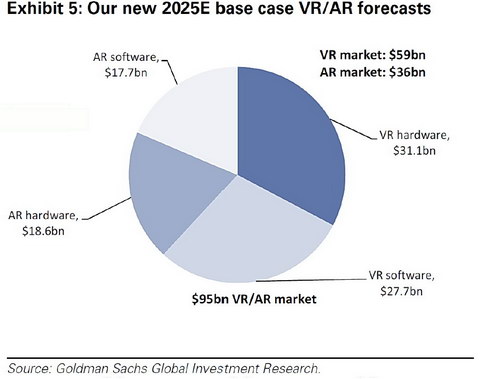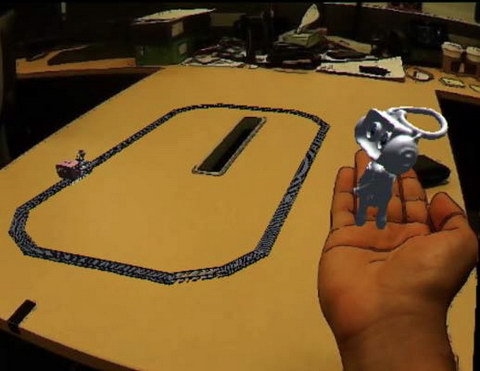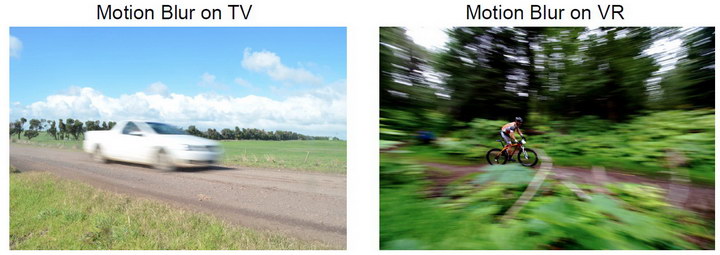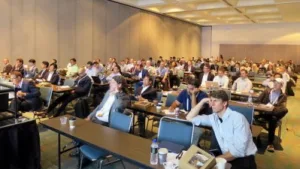This session was opened by a brief introduction by Barry Young, CEO & President of the OLED Association and Conference Co-Chair.
The first regular speaker of the session was John Fan of Kopin and was titled “The Coming Era of Microdisplays for AR and VR.” Much of his talk was just hype for the future of AR and VR, and the advantages of Kopin microdisplays in the market. Since I visited Kopin in their suite in the JW Marriott adjacent to the Convention Center and have written up that meeting for this SID Display Week report, I’ll skip writing about Kopin here.
The next speaker was Mats Johansson, co-founder and CEO of Eon Reality and his talk was titled “How can Virtual Reality and Augmented Reality address the increasing knowledge transfer needs caused by technology disruption?” Johansson started by identifying a pair of related problems. First, the economy is in continuous churn with old jobs being eliminated and new jobs being created. Unfortunately, the workers losing the old jobs rarely have the skill sets to qualify for the new jobs. The second problem is the need to teach more with less time and less money. This includes not just new skills to workers but basic literacy and math skills to children. He said there was a shortage of about 18M teachers world wide with a shortage of 2.3M in the US and 1.2M in India. He didn’t even give an estimate of the teachers needed in sub-Sahara Africa.
His solution? More VR and AR in education. He cites a forecast that says 85% of the growth in AR and VR will be in non-gaming applications such as education and training. Eon Reality supplies software systems for the creation and distribution of VR and AR content. According to Johansson, Eon Reality’s strategy is “to build the world’s largest content development & distribution capacity for knowledge transfer through our Interactive Digital Center network to meet the VR AR demand from the rapidly growing non-gaming sources.”
He showed a slide of “what studies show” (without citing the study) that showed a relatively simple task that took 120 minutes of conventional training, but could be done in 10 minutes with AR training. A more complex task (operating an oil drilling rig) that took 24 months with conventional training could be done in less than 9 months with simulator (VR) training. If these time reductions are proved valid, AR/VR will, indeed, be a boon to education and training.
Like several other speakers at the AR/VR business conference, Johansson cited a forecast for 2025 from Goldman Sachs. This $95B market just 8 years from now, if the forecast is correct, certainly justifies the building of AR and VR software infrastructure. He also showed a forecast from Markets and Markets indicating the total VR/AR market in 2022 will be $150B. Again, this shows up the contradictions and uncertainties in different AR/VR market forecasts.
 AR/VR Revenue Breakdown Forecast by Goldman Sachs for 2025 (Image: Eon Reality)
AR/VR Revenue Breakdown Forecast by Goldman Sachs for 2025 (Image: Eon Reality)
Richard Marks is the Director of PlayStation Magic Lab and a Research Fellow at the Interactive Entertainment group at Sony and his talk was titled “Opportunities and Challenges of Spatial, Proximal Interfaces.” While Johansson focused on professional applications of AR/VR, it’s not surprising that Marks focused on entertainment applications and the user interfaces for VR, AR, and Mixed Reality (MR) entertainment applications.
For MR entertainment, the user would wear a (Sony PlayStation VR) HMD that completely obscures the outside world, but the outside world has a presence in terms of either stick figures of people, chairs, etc. or camera input of the outside world. The MR image would also include images of the user’s hands. One of the issues of VR/AR/MR is what the viewer can see and what he can’t see – i.e. occlusion. If a user picks something up, for example a small robot, the robot should occlude part of the hand and the hand should occlude the background, as shown in the image. When the image of the robot, hand and background are all virtual, this is a relatively solvable problem.
In MR, where the hand and/or background are from a camera, it becomes a much more difficult problem. Marks described this and other VR/AR/MR interface problems in gaming and other entertainment applications. Presumably, Sony Interactive Entertainment is working on solutions.
 The hand occlusion problem presented by Richard Marks (Image: Sony Interactive Entertainment)
The hand occlusion problem presented by Richard Marks (Image: Sony Interactive Entertainment)
Taesung Kim, VP at Samsung in the Samsung Mobile Communications group, gave a talk titled “Special Considerations and Trade-Offs in Display Technologies for VR Devices.” He focused on the technical problems of VR HMDs, including the extremely wide field of view (FOV), the screen door effect, lens-related optical artifacts such as chromatic aberration and distortion, dark and bright scene performance of the display and motion blur.
Motion blur is due to a variety of factors with the most important being latency, or “motion to photon delay. It is well known that VR HMDs cause VR sickness and dizziness. He gave some specific recommendations to solve these problems and reduce VR sickness. For example, he said the latency, including both the system processes and the display time, must be below 20mS. At 90 Hz, this is only 8.9mS longer than the frame time of the display, leaving very little of the latency budget for the system processes and data transfer.
 Examples of TV and VR motion blur (Image: Samsung Electronics Co.)
Examples of TV and VR motion blur (Image: Samsung Electronics Co.)
Kim noted that some of the human factors issues with displays are very different for VR systems than they are for TV or cinema systems. Motion blur, for example, in TV is mostly limited to the object moving across the TV screen, as shown in the left image above. In VR, if the head is tracking the object of interest, as shown in the right image, the object of interest may not be blurred but the background is badly blurred. Another example is in VR there stimuli from the human vestibular system in the ear when the head is moved. This probably will not match the visual stimuli from the VR scene, leading to VR sickness. In TV or the movies there is rarely any significant vestibular stimuli since the viewer’s head largely stays still.
These issues, especially the FOV issue, were also covered by Nupur Kala and his seven colleagues from Samsung in the Technical Symposium paper P-218. That paper particularly emphasized the quantitative evaluation of VR sickness and the reduction of VR sickness through the control of the FOV and other image content parameters. They show that reducing the vertical FOV alone can reduce VR sickness by 28.8% – 31.4%, depending on whether the reduction is fixed and permanent or adaptive to the image content.
The featured speaker at the end of this session was John Underkoffler, Founder & CEO of Oblong Industries. He discussed some very futuristic concepts, including his Pixel Operating System (patent pending). I won’t try to explain what the Pixel Operating System is: just watch the opening scenes from Minority Report and you’ll understand what he is talking about. Underkoffer, not coincidentally, was a science advisor for Minority Report, My thought when I understood what he was talking about was “Why would anyone want a display and operating system like that? It’s just a 2002 vision of the future and we already have much better systems in 2017.”

